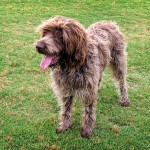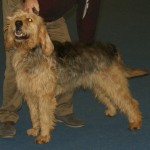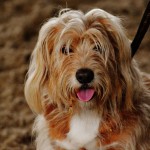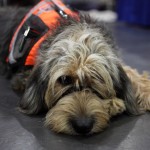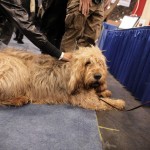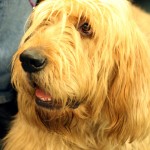Otterhound
"Otterhounds are rarer than pandas and are considered one of the most endangered dog breeds."
Country of origin:England, Great Britain
Traits:
Weight:Male 115 pounds, female 80 pounds
Height:Male 27 inches, female 24 inches
Coat:Medium length double coat, with a soft undercoat and longer rough outer coat.
Color:Black and tan, blue, gray, lemon, liver, tan, white, wheaten, blue and cream
Litter size:2-14
Life span:10-13 years
Classification:
AKC - American Kennel Club: Hound
UKC - United Kennel Club: Scenthound
NZKC - New Zealand Kennel Club: Hound
FCI - International: 6 - Scenthounds, 6.1 - Scenthounds
Otterhounds are one of the more unusual looking dog breeds on the market. Due to their strange-looking appearance, these dogs aren’t as popular as they should be. Fortunately for fans of the otterhound breed, popularity is just a matter of time.
The otterhound is a natural scent hound who excels in smell tracking, trailing and trailing with other dogs. This makes them excellent hunting dogs who can track wild animals and follow scent trails in the woods, marshes and swamps. These qualities have made them perfect for hunting waterfowl like beaver or muskrat. The otterhound is also naturally curious about both our world and that of other creatures so it makes an excellent pet as well.
History & Origin
Otterhounds are a type of scent hound that was developed in England. These dogs are a type of scent hound known as a beagle. However, beagles are used for hunting various small animals, while otterhounds are more focused on tracking and trailing larger game species like beaver or muskrat.
Beagles have been around for centuries so it is not surprising that breeders decided to create a new type of beagle. However, for the beagle to be more effective at tracking and trailing, breeders needed to make some significant changes. To make this happen, breeders chose the beagle’s smaller size and Otterhound’s strong scenting ability.
Appearance and Characteristics of the Otterhound
As a relatively new breed, the exact appearance of a typical Otterhound is not well-established. Otterhounds are usually between 20 to 27 inches in height and weigh between 50 to 90 pounds. Though they are usually small-sized dogs, but they can grow to be a bit bigger if they are given enough exercise and proper nutrition.
Otterhounds are usually built strong with a stocky build. Their coat is usually short, smooth and shiny. However, certain colors like black and tan have also been seen in the breed. Their coat colors can also be quite varied. Some of the most popular colors in the Otterhound are white, red and bluish-gray.
As for the otterhound’s coat, it is a bit more dense than some other scent hound breeds. This is because the dog needs to stay warm when it sniffs through cold and rainy weather.
Shedding and Grooming Requirements
Otterhounds are a very low-maintenance breed. Most of their grooming is done when their coat is trimmed or when they need to be groomed after a bath. They are a fairly easy-to-manage breed and they don’t usually require a lot of grooming.
- You can brush their coat once a week using a regular dog brush or a slicker brush.
- You must remove tangles in the coat using a metal comb. You can also use a handheld grooming tool to remove dead hair or tangles.
- You can also use a bristle brush to remove loose hair or plucked-out hair.
When it comes to bathing, you can use a mild shampoo for dogs that is specially formulated for Otterhounds. However, you can also use a baby shampoo diluted with water. You can use a soft towel to dry up the dog.
You should also brush their coat once dry. If you keep your Otterhound indoors, you can use a dog-specific drying towel. If your pet is allowed to go outside, you can use a mild dog shampoo formulated for coat care. You can also use a comb to remove dead hair from the coat.
Health Concerns
The most significant health concern for the otterhound is the herding instinct, which is a very common trait in beagles. This herding instinct, although a great asset when hunting, can be a problem when raising puppies. You must exercise control over this instinct and make sure that your dogs don’t herd your puppies.
Another health concern for the otterhound is hip dysplasia, which is a disorder that occurs when the ball and socket joint of the hip is not formed normally. The condition can be corrected with surgery or medication, but if not controlled, it can lead to severe disabilities and even death.
Popularity of the Otterhound
The otterhound’s popularity is rather new. The breed was only recognized as an official breed in the United Kingdom in 2003, so it is not surprising that it has not yet been approved for showing in other countries. However, the otterhound is gaining popularity among dog enthusiasts and owners.
These dogs are very intelligent and they make great pets. They are also extremely loyal to their owners and very easy to train. They are also fairly active, so they make great outdoor companions. If you are looking for a scent hound that can hunt waterfowl or aquatic mammals like muskrat, beaver and opossum, the otterhound is a good choice.
These dogs can also be great pets for families as they are very obedient and easy to train.
Final Words: Why You Should Get an Otterhound
The otterhound dog is a medium-sized breed of dog that was originally bred in England as a water retriever. Today, the otterhound is used primarily as a hunting dog, but it can also be used for tracking, herding, and security work.
These dogs are also very intelligent and easy to train and very loyal to their owners. The otterhound is a natural scent hound and an ideal choice for those who want a versatile hunting or tracking dog.
Otterhound Photo Gallery
You can click on the gallery images below to view them full sized (most are in wallpaper resolution!).



















